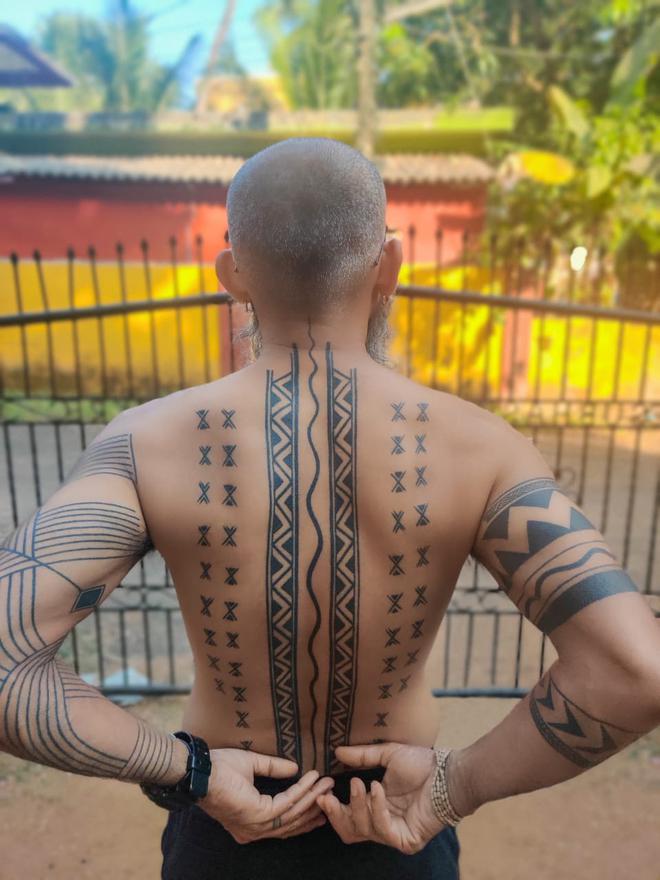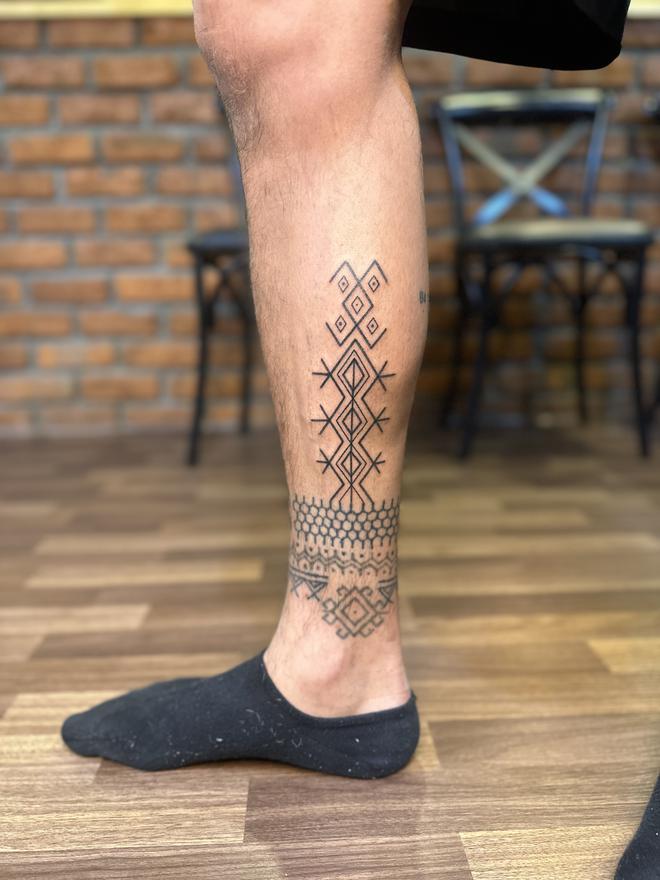About a dozen Narikuravars sit under the trees on Marina beach, tattooing tourists, the buzz of their machines creating a dull symphony. Among them is D Rajini (44), who has a tattoo of an eagle covering his back.
Rajini says that the last time he saw people seeking traditional designs — flowers, kolams and bundles of crops — was when his mother’s generation got tattooed. “Youngsters prefer the latest designs. The old ones had a lot of lovely shading that we no longer see,” he says, tattooing cartoon hearts on a customer’s forearm.
The Narikuravar community in Tamil Nadu has long been associated with pachai kuthal. This art form that uses the skin as its canvas imparts a green tinge due to the ink, made of herbs and soot. This nomadic community first began using thorns, then needles. They moved to tattoo machines only about three years ago.

The ink too no longer leaves a green fade. Rajini and his colleagues buy synthetic tattoo ink from Bengaluru and Goa, marking a definite shift in their tradition. When asked if he believes that pachai kuthal is disappearing, Rajini is quick to get offended. “As long as I am alive, why would it disappear?”
The art of tattooing in India as a marker of lineage and culture lies in this exact paradox. While there is little documentation of traditional designs and tattooing methods of Indian tribal communities, a handful of artists are choosing to protect the designs by sharing the wealth with others.
Now, there are tattoo archives, conversations about appropriation, and even the dream of a tattoo village.
Finding meaning
When reputed Gond tattoo artist Mangla Bai began tattooing Gond and Baiga designs, she was only seven. This artist from Lalpur village in Madhya Pradesh’s Dindori district travels across the country, patterning thick black lines, on those who seek her out. She says that nearly all young members of her community, particularly women, are inked when they are eight or nine-years-old. Baiga tattoos were spread across the body — from head to toe. While most denote Nature, some denote the passage of life. Women also used to wear tattoos on their foreheads.

Tattoos have been used to demonstrate social identity, particularly one’s clan and age, says Sahana Rao, an independent culture curator, adding that it was also a form of adornment on people’s bodies.
Hand-poke tattoo artist Shomil Shah, who runs India Ink Archive says that while animals, flowers, plants, gods and chariot designs are used across the country, the most common one across cultures is the scorpion.
The process

Moranngam Khaling, also known as Mo Naga, who has been striving to unearth the meaning and relevance of tattoos of tribes from Nagaland says, “They are poetic, a form of telling a story. ”Most tattoos that Mo has documented of different Naga tribes have vastly different styles, though all their inspiration is from Nature.
Mo’s own work showcases flowing lines rooted in symmetry — all drawn without the use of stencils. The artist says that tattooing freehand is liberating and that his clients trust his work .When Mangla Bai began touring with her parents who taught her the craft, she used a machine.
She says, “However, I quickly switched because I was most comfortable with the needle. The ink that I make comes from my house. It is similar to a kajal made of black sesame and other local herbs. I finish the tattoo by applying turmeric, an antiseptic.”

Similar traditions have been followed across the country including by the Narikuravars, tribal communities from the East, tattoo artists from the Kutch region and other tribal groups in Karnataka and Andhra Pradesh.
Mo says that hand-tapping tattoo where hand-held instruments are used for tattooing ink onto the skin, are also a common practice among Naga tribes.
N Ramki, a member of the Narikuravar community, who resides in Ambur says it is only in the last 30 years that they have switched from thorns to needles. “We used bicycle spokes as needles. We however moved to using tattoo guns and machines as they were less painful,” he states.
Changing the discourse
Mo says he is miffed when he hears about the perception of street and tattoo artists using unhygienic practices.
“In the past, most tattoo artists used antiseptic herbs, breast milk and sterilised thorns to ensure safe tattooing. The aftercare for tattoos would involve clean ingredients that would soothe the fresh tattoo including turmeric and oil. The discourse around hygiene in tattoo parlours is recent. Many new artists from the community are ready to move towards safer practices. They just need to be taught,” he says.

Mo says that interested clinents ideally, should not pick designs off social media and expect artists to tattoo ‘tribal’ designs. “There needs to be a conversation about indigenous people being empowered enough to tattoo their designs to prevent appropriation,” he says.
He adds that documentation and workshops by the Indian Government’s Ministry of Culture would go a long way in safeguarding a long tradition in the country.







